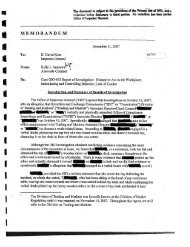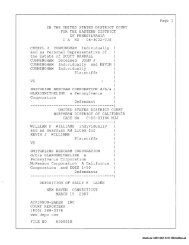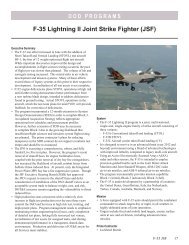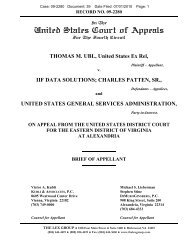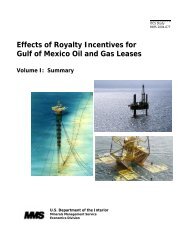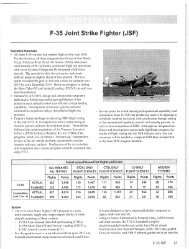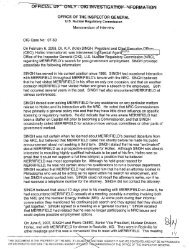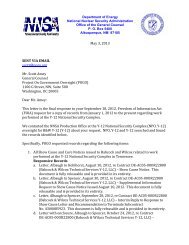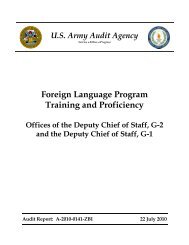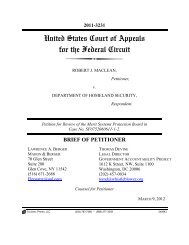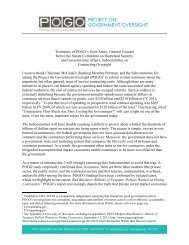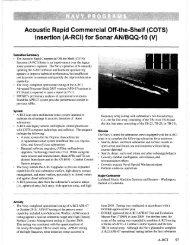F-35 Joint Strike Fighter (JSF)
F-35 Joint Strike Fighter (JSF)
F-35 Joint Strike Fighter (JSF)
You also want an ePaper? Increase the reach of your titles
YUMPU automatically turns print PDFs into web optimized ePapers that Google loves.
Air System-Ship Integration and Ship Suitability Testing<br />
• Coordination continued between the <strong>JSF</strong> program office,<br />
Naval Sea Systems Command, and Naval Air Systems<br />
Command offices responsible for planning and implementing<br />
actions to integrate the <strong>JSF</strong> aircraft and support systems<br />
on naval ships. The teams focused efforts on readiness for<br />
initial ship trial periods that the program now plans in late<br />
2011 (one year later than previously planned), as well as on<br />
planning the other actions needed to achieve initial operating<br />
capabilities of the B-model on L-class amphibious ships and<br />
the C-model on large-deck carriers.<br />
• The coordination teams are working significant issues in<br />
these areas: identification of personnel hazard zones around<br />
B-model aircraft, interoperability of the Autonomic Logistics<br />
Information System with Service and joint systems, carrier<br />
jet blast deflector modifications needed for CV aircraft<br />
operations, aircraft-ship connectivity for alignment of inertial<br />
navigation systems. secure facilities for handling special<br />
access material, and spectrum limitations.<br />
• The first ship trial period for the B-model STOVL aircraft<br />
has slipped from March 2011 to no earlier than late 2011 due<br />
to the slow flight test progress in accomplishing the shorebased<br />
build-up test points. The first C-model trial period on<br />
a large deck carrier is planned for early 2013.<br />
Live Fire Test and Evaluation<br />
• LFT&E conducted On-Board Inert Gus Generations System<br />
(OBIGGS) tests during FY09-FY10.<br />
• The Weapons Survivability Lab at China Lake took delivery<br />
of the Full-Up System-Level (FUSL) F-<strong>35</strong> aircraft. The<br />
aircraft is being prepared for ballistic testing. The test team<br />
will begin this testing in IQFY11.<br />
Assessment<br />
Test Schedule Re-Planning and Implementation of Changes<br />
• The year-long process of analyses during FY 10 (,1E111<br />
implementation. Nunn-McCurdy certification. and TBR)<br />
served to develop a more realistic estimate of SDD<br />
completion for Block 3 in all variants and identify steps<br />
to reduce risk in execution of the verification test and<br />
evaluation strategy. Although the sample size of experience<br />
with the CV is still small, the STOVL design emerged as the<br />
highest risk of all variants and the most difficult to progress<br />
through flight test. This is due in part to the difficulty in<br />
making progress in vertical lift operations compared to that<br />
planned. The analyses also revealed that the F-<strong>35</strong> mission<br />
systems software development and test is tending towards<br />
familiar historical patterns of extended development,<br />
discovery in flight test, and deferrals to later increments. The<br />
modifications recommended by the TBR (lower fly rates,<br />
more regression and re-fly margin, more nights, and other<br />
resource additions) that result in completion of SDD flight<br />
test for Block 3 in all three variants later than previously<br />
estimated are realistic and credible. Completion of STOVL<br />
flight sciences in this timeframe is dependent on whether<br />
or not the necessary changes to STOVL design can be<br />
implemented and tested. It will also depend on whether<br />
these changes result in fewer aircraft operating limitations<br />
and greater aircraft availability for test. The program will<br />
potentially need as much as a year longer than the other<br />
two variants to complete this variant's Right sciences and<br />
ship integration testing. The expectations approaching<br />
10 to 12 flight sciences sorties/month/aircraft in previous<br />
schedules are not achievable in the flight test program until<br />
changes are made to all variants that improve reliability<br />
and maintainability in flight test operations, Additionally,<br />
the process must begin to reduce the aircraft operating<br />
limitations, which inhibit flight test progress particularly in<br />
vertical lift STOVL testing.<br />
• Mission Systems flight test still contains significant<br />
uncertainty, which will affect any estimate of a Block 3<br />
completion date. This is primarily due to the delays<br />
incurred in development thus far and the filet that only the<br />
Block 0.5 flight test plan has actually been completed and<br />
approved. A test plan for Block 1 is currently in review<br />
by test center authorities, and the Block 2 test plan is in an<br />
initial draft state. Additionally, technical issues in the helmet<br />
mounted display and sensor fusion. along with uncertainties<br />
pertaining to new capabilities with which the program has<br />
limited experience on the F-<strong>35</strong> aircraft (multi-function<br />
advanced data link, distributed aperture system, infrared/<br />
electro-optical fused sensor tracks) are risks that affect<br />
the ability to accurately predict the conclusion of mission<br />
systems flight test. Completion by early 2016 is possible<br />
provided further delays in delivery of Block 2 and Block 3<br />
software are not incurred, and the program can overcome the<br />
helmet mounted display problem before Block 2 flight test<br />
must begin, Mission systems labs and CATB are important<br />
to software integration and test; use of these assets has<br />
enabled the resolution of many problems before flight test.<br />
However. F-<strong>35</strong> flight test must include integration sorties to<br />
demonstrate software performance before performing flight<br />
test points for verification of capability, F-<strong>35</strong> flight test for<br />
the purposes of software and sensor integration has not been,<br />
but needs to be, an explicit part of the flight test plan such<br />
that integration precedes verification events.<br />
• The TBR also revealed a number of changes needed<br />
to directly support the Edwards and Patuxent River<br />
Integrated Test Force flight test centers to assure the<br />
highest possible rate of execution. Recommendations for<br />
additional maintenance and test operations work forces,<br />
improving spare parts supply chain management, increasing<br />
engineering support for test data analysis, standardizing<br />
network connectivity at all sites, and improving priority of<br />
the program on test ranges are credible, important efforts<br />
that need follow-up and require sustained emphasis for the<br />
duration of SOD flight test.<br />
Verification Simulation for Operational Test and Evaluation<br />
• Open-air testing is constrained by range limitations that<br />
are incapable of providing realistic testing of many key<br />
capabilities provided by Block 3 aircraft. Consequently, a<br />
F-<strong>35</strong> ,<strong>JSF</strong> 17



